Blog
How to Store Your Piano When Moving or Renovating
Pianos are valuable, delicate instruments that require special care when it comes to storage, especially during moves or home renovations. Whether you’re relocating to a new house, undergoing a renovation project, or simply need to store your piano temporarily, ensuring its safety and maintaining its condition is crucial.
In this guide, we’ll walk you through the best practices for storing your piano during a move or renovation, covering key considerations for different types of pianos, proper packing methods, and storage conditions. Proper storage can prevent damage and preserve your piano’s sound quality and longevity.
Why Proper Storage Matters for Your Piano
A piano is a large, heavy, and sensitive instrument, and improper storage can lead to several issues, including:

- Physical damage: Scratches, dents, or structural damage caused by improper handling or exposure to moisture and temperature fluctuations.
- Out-of-tune strings: Extreme humidity or temperature changes can cause the piano’s strings to go out of tune or become warped.
- Moisture damage: Pianos can absorb moisture from the air, which can damage the wood, cause rusting of metal components, or even lead to mold growth.
- Increased maintenance needs: A poorly stored piano may require more frequent tuning, repairs, and maintenance once it’s back in use.
By following the proper steps to store your piano during a move or renovation, you can avoid these issues and ensure your piano is in top condition when you’re ready to play again.
Steps to Properly Store Your Piano During a Move or Renovation
1. Hire Professional Movers (If Possible)
If you’re moving a grand piano or upright piano, it’s often best to hire a professional piano moving company. These experts have experience in transporting pianos and have the proper tools and equipment to handle your instrument safely.
- Grand Pianos: Due to their size and delicate components, grand pianos require special handling, including disassembling the legs and pedals, wrapping the piano securely, and using a piano dolly.
- Upright Pianos: While upright pianos are smaller and more manageable than grand pianos, they still need careful handling. Professional movers will know how to protect the finish and keep the action intact.
Hiring professionals can save you time, energy, and potentially costly repairs if the piano is damaged during the move.
2. Protect the Piano with Proper Packing Materials
For both moving and storing your piano, it’s essential to protect it from damage using appropriate packing materials. Here’s what you’ll need:
- Blankets or Moving Pads: Wrapping the piano in thick moving blankets or moving pads will protect it from scratches, bumps, and dirt. You can secure the blankets with packing tape or straps.
- Bubble Wrap: Use bubble wrap for added protection, especially around delicate areas such as the keys, pedals, and the fallboard (the lid over the keys). Avoid wrapping the entire piano in bubble wrap as it can trap moisture.
- Stretch Film or Plastic Wrap: For extra protection against dust and dirt, you can wrap the entire piano in stretch film. This will keep the blankets in place and provide a layer of insulation against temperature changes.
- Piano Cover: If you have a piano cover, this is the ideal way to protect the surface from dust, scratches, and environmental factors when storing the piano for a longer period.
Be sure to wrap the piano in multiple layers of these materials, especially if it’s being stored for a long time.
3. Choose the Right Storage Location
The location where you store your piano during a move or renovation is extremely important. It’s essential to keep the piano in an environment that is both temperature and humidity-controlled to prevent damage. Here are some tips for choosing the best storage location:
- Avoid Basements and Attics: These areas are usually prone to extreme temperature and humidity fluctuations, which can damage the piano’s wood and metal components. Instead, opt for a climate-controlled space like a storage unit designed for delicate items.
- Stable Temperature and Humidity: The ideal temperature for piano storage is between 68°F to 72°F (20°C to 22°C), and the humidity should be between 40% and 60%. Extreme dryness or humidity can cause the piano’s wood to expand or contract, affecting its tuning and tone quality.
- Away from Direct Sunlight: Avoid storing the piano in direct sunlight, as this can cause the wood to warp, crack, or fade. Choose a shaded location, ideally with minimal light exposure.
A climate-controlled storage unit is a great option, especially if you’re unsure whether the space in your home is suitable.
4. Remove All Accessories and Loose Parts
Before moving or storing your piano, it’s a good idea to remove any accessories and loose parts to prevent them from getting lost or damaged during the process. This includes:
- Sheet music, books, and other accessories: Place these items in a safe, dry location where they won’t get damaged.
- Pedals: If you’re moving a grand piano, you may need to detach the pedals to protect them during transport. Store them separately in a safe place.
- Action and Internal Parts: Some pianos may have action parts (the internal mechanism that connects the keys to the hammers) that are vulnerable to shifting. A professional piano mover or technician can ensure these parts are secured properly before storage.
5. Keep the Piano Upright
If you’re storing an upright piano, make sure to store it standing upright, as it’s designed to be stored this way. Laying it down can put undue pressure on the structure and internal components, potentially causing damage.
For grand pianos, if you’re storing it in the case or moving it, make sure it’s properly supported on a dolly or moving frame to prevent tipping or uneven weight distribution.
6. Monitor and Maintain the Storage Environment
While your piano is in storage, it’s important to check the storage conditions regularly, especially if it’s in a non-climate-controlled space. Here’s how to ensure the environment stays suitable for your piano:

- Use a Hygrometer: A hygrometer measures the humidity level in the storage area. If the humidity falls outside the 40%-60% range, consider using a humidifier or dehumidifier to bring the levels back to the ideal range.
- Temperature Control: If possible, monitor the temperature in the storage area. Extreme heat or cold can cause the piano’s wood to expand or contract, potentially warping or cracking it.
- Check for Pests: Be mindful of pests like rodents or insects that can damage the piano’s wood. Make sure the storage area is free from any potential infestations.
7. Consider Piano Storage Insurance
If your piano is particularly valuable, or if you’re storing it in a third-party storage facility, consider purchasing piano storage insurance. This will provide coverage in case of damage due to environmental factors, theft, or mishandling.
Many professional piano moving and storage companies offer insurance packages specifically for pianos, so inquire about this when arranging for storage.
Conclusion
Storing a piano during a move or renovation requires careful planning and attention to detail. By hiring professional movers (if possible), packing the piano with the right materials, selecting an appropriate storage location, and monitoring the environment, you can ensure your piano remains in excellent condition until it’s time to bring it back into your home.
Remember, temperature and humidity control are key factors in preserving your piano, so invest in a climate-controlled storage space if necessary. With the right precautions, your piano will be well-protected and ready to play when you’re ready to enjoy it again.


